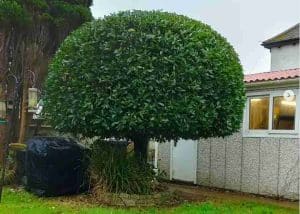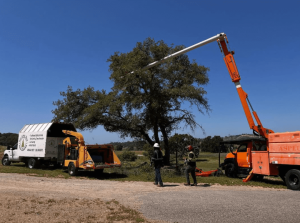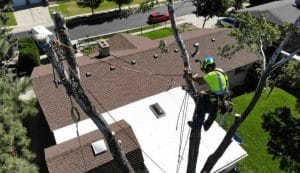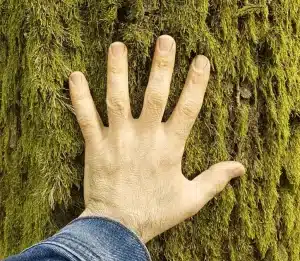If you’re getting ready for hurricane season in Florida, don’t forget to remove a tree stump from your yard — it could save you from major damage. When the ground becomes saturated during heavy rains, stumps can loosen and become dangerous projectiles in high winds. Even worse, they attract pests like termites, ants, and rodents that often move closer to your home during storms. In this guide, we’ll explain the top 5 reasons why removing a tree stump now is one of the smartest ways to protect your property, improve drainage, and make storm prep easier.
Table of Contents

Let’s explore the top five reasons to get that tree stump out of your yard before the next big storm arrives.
1. Stumps Can Uproot in Saturated Soil and Become Dangerous Projectiles
During hurricanes, Florida often experiences days of heavy rainfall followed by intense wind gusts. When the ground gets saturated, even a buried stump that seems solid can shift or become uprooted.
Why is this a problem?
- Exposed roots or partially decayed stumps can get loosened by waterlogged soil.
- Once dislodged, these stumps can roll or bounce during high winds, especially on sloped yards.
- They can damage fences, break windows, or even become airborne if torn out completely.
Imagine a stump smashing into your garage or a neighbor’s house during 80-mph winds. The risk is real — and avoidable.
Removing a tree stump eliminates this hazard entirely. It’s a proactive step to protect both your property and those around you.
2. Stumps Attract Pests That Thrive in Florida Storm Conditions
Old stumps are a magnet for pests, and many of them become even more active in humid, storm-prone environments. Leaving a stump in your yard is like rolling out the welcome mat for:
- Termites
- Carpenter ants
- Rodents and snakes
- Fungus and mold
These pests don’t just stay in the stump. When hurricanes hit and the stump shifts or floods, these unwanted guests often move toward your home for shelter.
Additionally, standing water in or around stumps becomes a breeding ground for mosquitoes, increasing your family’s risk for bites and diseases like West Nile or dengue.
By removing a stump before the season starts, you remove their habitat and cut off their reason to hang around.

3. Tree Stumps Can Obstruct Drainage and Cause Local Flooding
Hurricane rains dump massive volumes of water in short timeframes. Florida yards need to drain quickly to prevent flooding around homes and structures. But a leftover tree stump, especially one with remaining root systems, can block this natural flow.
Here’s how:
- Old root systems continue to divert or block water, especially if they reach under sidewalks or driveways.
- Stumps can trap debris, creating a dam effect during downpours.
- Pooled water near your foundation leads to flood damage, mold growth, and soil erosion.
Clearing the stump helps restore natural drainage patterns and allows rainwater to flow away safely. This keeps your foundation dry, your yard functional, and your stormwater systems clear.
4. Stumps Make Emergency Storm Prep and Cleanup Harder
When a storm is forecasted, you often have just a day or two to prepare. Having a stump in your yard complicates things:
- It limits where you can place sandbags or storm barriers.
- It can interfere with tarps, sheds, or vehicle movement during pre-storm securing.
- After the storm, cleanup teams may have to work around the stump, slowing recovery.
Emergency services and power restoration crews also find stumps to be hazards or obstacles, especially if they’ve been hidden under debris or floodwaters.
Removing the stump ahead of time makes your yard easier to manage, safer to navigate, and more accessible for storm prep and cleanup.
5. Stump Removal Helps Prevent New Tree Growth That Could Be Risky Later
In Florida, nature takes over quickly. Even an old stump can sprout new growth, especially in warm, wet summer conditions. This new growth might look small now, but in just a few months:
- The regrown tree may become structurally unstable.
- The new shoots may grow in directions that threaten power lines or roofing.
- You’ll be dealing with a bigger removal problem next hurricane season.
Proactive stump grinding or removal stops regrowth at the source, saving you future headaches and unexpected costs.
In fact, many homeowners who delay stump removal end up paying twice — once for cutting back regrowth, and again for grinding the root.
Get it done once. Do it right. Be ready before the storm.
Bonus: Tree Stump Removal Boosts Your Property’s Safety and Value
While our focus is on hurricane prep, it’s worth noting the year-round benefits:
- Fewer tripping hazards for kids, pets, and guests.
- Improved curb appeal if you plan to sell or rent your property.
- Easier to mow and landscape without a stump in the way.
- More usable yard space — perfect for outdoor furniture or play areas.
The return on investment for stump removal is more than just storm protection — it’s about maximizing your yard’s potential and safety.
Tips for Preparing Your Yard for Hurricane Season
While removing tree stumps is a critical step, there are other ways to make your yard hurricane-ready. Here are a few tips to complement your stump removal efforts:
- Trim Trees and Bushes: Cut back overhanging branches or weak limbs that could break off in high winds. This reduces the risk of debris damaging your home.
- Secure Outdoor Items: Store or anchor lawn furniture, grills, and decorations to prevent them from becoming projectiles.
- Check Drainage Systems: Ensure your yard’s drainage is clear to prevent flooding. Removing stumps helps with this, but also check gutters and storm drains.
- Plant Smart: If you’re replacing the tree, choose hurricane-resistant species like live oaks or sabal palms, which are better suited to Florida’s climate.
By combining these steps with stump removal, you create a safer, more resilient property that can withstand the worst of hurricane season.
Why Timing Matters: Act Before Hurricane Season Hits
Hurricane season in Florida runs from June 1 to November 30, with peak activity in August and September. Waiting until a storm is on the horizon to remove a stump can be risky. Professional services often get booked up as homeowners rush to prepare, and last-minute removal may not be possible. Plus, grinding a stump in wet, stormy conditions is harder and messier, which could delay the process.
By acting now, you give yourself plenty of time to address the problem properly. You’ll also avoid the stress of scrambling when a hurricane watch is issued. Early preparation means you can focus on other storm-readiness tasks, like stocking supplies or reinforcing your home, without worrying about that stump in your yard.

Conclusion: A Small Step for Big Protection
Tree stumps might seem like a minor nuisance, but in Florida’s hurricane-prone climate, they’re a problem waiting to happen. From flying debris to pest invasions, flooding issues to safety hazards, an old stump can cause serious trouble when a storm hits. Removing it before hurricane season protects your home, boosts your property’s value, and gives you peace of mind. Don’t let a small oversight turn into a costly mistake. By taking action now, you’re investing in your property’s safety and your family’s well-being. So, before the next hurricane warning lights up your phone, make sure that stump is gone for good your future self will thank you.
Whether you’re in Ormond Beach, Daytona Beach, Port Orange Florida, Ormond-By-The-Sea or anywhere along Florida’s storm-prone coast, don’t let an old stump become your next expensive or dangerous problem.
Take action this season because once the winds start howling, it’s already too late.
FAQs
Why remove tree stumps before hurricane season in Florida?
Removing tree stumps before hurricane season helps prevent them from becoming dangerous projectiles during storms, reduces pest infestations, and improves yard drainage, thereby protecting your property and family.
Can tree stumps cause flooding during Florida storms?
Yes, tree stumps can block natural water flow, leading to water pooling and increased flooding risk around your home during heavy rains common in Florida’s hurricane season.
Do old tree stumps attract pests in Florida?
Absolutely. Old stumps can harbor termites, ants, and other pests that may migrate to your home, especially during the warm and wet conditions of Florida’s hurricane season.
Is it safe to leave a tree stump in my yard during hurricane season?
Leaving a tree stump can be hazardous. During hurricanes, stumps can become uprooted and cause damage to your property or become obstacles during emergency situations.
How do tree stumps affect yard drainage in Florida?
Tree stumps and their root systems can obstruct water flow, causing poor drainage and increasing the risk of water damage to your property during Florida’s heavy rains.
Can tree stumps regrow and become a problem later?
Yes, some tree stumps can sprout new growth, leading to unstable trees that may pose risks during future storms if not properly managed.
What are the benefits of removing tree stumps before storms?
Removing tree stumps enhances yard safety, prevents pest infestations, improves drainage, and reduces potential damage during hurricanes, making your property safer and more resilient.
Does stump removal improve property value in Florida?
Yes, a clean, stump-free yard enhances curb appeal and can increase your property’s value, which is beneficial if you’re considering selling your home.
When is the best time to remove tree stumps in Florida?
The best time to remove tree stumps is before the hurricane season starts, typically before June 1st, to ensure your yard is prepared for potential storms.
Who should I contact for stump removal in Florida?
It’s advisable to contact a licensed tree service professional in your area who has experience with stump removal and understands the specific needs of Florida landscapes.




